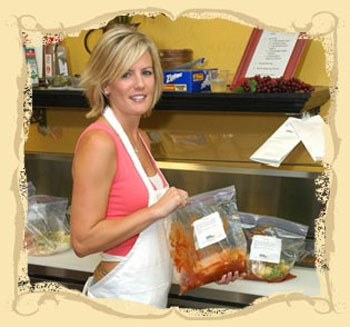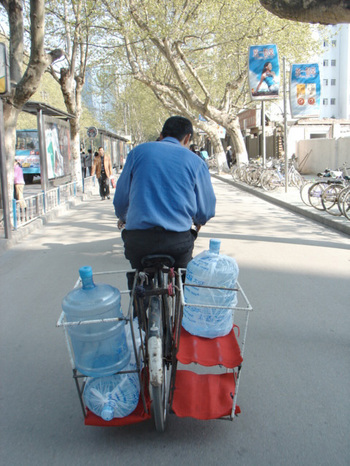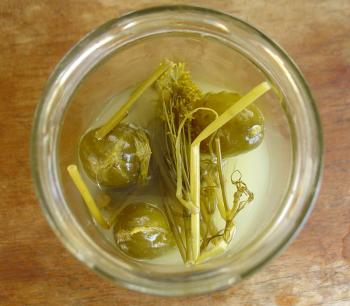An improbable history: meal assembly centers
March 26, 2006

image of friendly community hugging © Super Suppers, used entirely without permission
Kim Severson and Julia Moskin’s New York Times article about meal assembly centers has me all excited and flapping my wings. For other people. They report on Texan Judie Byrd’s service called Super Suppers, based upon the concept of the communal kitchen.
Here’s how it works: a suburban working person with family goes sans entourage to a central food preparation center where the food is prepped and waiting in a professionally stocked and staffed kitchen. Meandering from station to station (s)he assembles the week’s family meals, takes them home in zip-lock baggies made from compostable potato starch, freezes the meal-sized portions and heats them up when it’s time to get the grits on the table.
What is not to like about this practically utopian idea, for other people? As a predominately self-employed happily not married person with zero children, and as someone who finds almost all elements of food preparation thrilling, I realise this business model was not made with people like me in mind. But because I am insane and live in a bubble, here’s what I’m imagining:
1. The meal assembly center would stock its food exclusively from local farmers and artisanal producers, procuring the highest quality seasonal and local produce at a fair price. The meal assembly center would develop enduring relationships with these folks and the community using the meal assembly center would feel secure knowing that all of the food products they are using are made or grown with their well-being in mind.
2. In a professional kitchen with sharp knives and a seemingly limitless amount of freshly ironed tea towels (made from locally grown hemp), the meal assembly center’s assisting chefs have prepared cooking stations for an interesting range of recipes. This week there are cuts of meat from the local deer cull and some strange root vegetables, next week it’s traditional holiday fare from one of the region’s thirty-seven ethnic groups, the week after that, it’s all about vegan haute cuisine.
Whale washed up on the beach? No problem. The meal assembly center is hip to the community and the kelp is already rinsed. Finally you’re cooking as if you live where you live!
3. It used to be common to take homemade bread dough to a communal bakery for baking. Heq, it used to be common for a lot of people to be involved in the family’s cooking, sharing the workload, but also sharing the how-to and the chit-chat. At the meal assembly center, labour intensive dishes involving lots of stuffing, rolling, stretching and braiding could be prepared by the organisation or by other folks sharing the kitchen with an interest in these dishes. It would be a community that cooks, just like it was way back when, in the Wabac Machine.

image of Peabody and Sherman using the WABAC Machine (that’s pronounced ‘way-back’) © Jay Ward, used entirely without permission
4. The meal assembly center would be stocked with amazing community-tested equipment. Here’s your chance to try cooking on a wood burning stove. Want to smoke up some trout, stuff some sausage, make cheese, brew a stout beer? It’s all possible because the community would do it together.
If you have prepared food (for your family) in a food preparation center, I would really love to hear about your experience. But please do not burst my bubble and tell me it’s about Thai Mac ‘n Cheese and Turkamales.

image of zip-lock wielding working yoga mom © Super Suppers, used entirely without permission
- Kim Severson and Julia Moskin’s New York Times article on Super Suppers,food preparation centers
- Super Suppers
- Judie Byrd’s website
- Sara Wilson at Entrepreneur dot com talks about the business concept of Super Suppers
- Peabody’s Improbable History
- A blogger (let’s call him Greg from Life’s a Picnic) writes about his Super Suppers experience.
- Dream Dinners, just another meal assembly center
- Dr. Gurgles doesn’t feel at ease with the concept
- Even more Gurgles from a time long past. Respect to the Gurgling Cod has followed this story in all its New York Times Magazine ugliness from the start.
technorati tags: food preparation centers, meal assembly centers, working moms, locative food, food trend, coommunity
The Super Suppers service says it’s designed to facilitate families eating home-cooked meals together again, a noble ambition. The down side is that the cooking described in the article about the Super Suppers service all points to women doing the cooking. Not that there’s anything wrong with women cooking, I’m all woman and I love to cook. But it I thought that the third feminist wave had taken care of the predominance of women dealing with basic nourishment in the home. Reality check.
From Severson’s article, “Although women still do eighty percent of the food-related work at home, the amount of time Americans spend cooking dinner has declined to about 30 minutes from about two and a half hours since the 1960’s, according to market research by Mintel International and the NPD Group.”
A HREF=”http://www.dreamdinners.com/main.php?static=index” TARGET=”_blank”>From the Dream Dinners website: Does Dream Dinners use organic ingredients?
Dream Dinners would love to provide more organic meats and produce for our guests. Presently though, all of our food products are provided by Sysco Foods, which is a national food distributor. At this time, Sysco does not carry a large selection of organic food products. For Dream Dinners to purchase these types of foods from another vendor on a national level would result in substantially higher costs for our guests. Our goal is to provide great family dinners at prices affordable for all our guests.
Does Dream Dinners use hormone-and antibiotic-free meats?
Although Dream Dinners cannot guarantee that the meat products used in our meals are antibiotic- and hormone-free, we can assure you that the food products we use are of very high quality. Dream Dinners food products are similar to those used in fine restaurants, schools, hospitals, etc.
debra at 22:40 | | post to del.icio.us



















I do love the idea of it though, especially with the state-of-the-art equipment. I also love the community aspect of it all.
Comment by Christiane — March 27, 2006 @ 3:21
Yeah, and the food preparation centers are located within the community, not in a strip mall. The people share the recipes to further build community. “Graduates” of the preparation center take their skills and experience to purchase food in the future from known suppliers. They care about the source of the food.
They make their pestos with a mortar and pestle. Flour is ground by hand and churning butter replaces prime time television. Children taste and savor the food after preparing it all day.
Ahh, dream world.
Comment by matt — March 27, 2006 @ 4:38
Yes Christine, it’s cool, like a sewing circle. I used to love going to Secret Sewing Circle and chilling with the ladies. It was like an oasis in the busy-ness. For some reason that all ended when all those ladies had babies.
Would it be cool if there were Agas and state of the art kitchen, the most Japanese of knives. And occasionally a prep chef walks by and helps you peel the daikon paper thin and then shows you how to frost a cupcake?
Here’s the URL of the location page. Maybe there’s one in your area? I don’t know if you fit the Super Suppers profile, but would you try something like this?
http://www.supersuppers.com/locations.php
If there was one in my neighbourhood, I would, but I wouldn’t feel the least bit obliged to make the recipes that they had prepared. I’d use the stations and just make whatever I wanted. If someone admonished me, I would just pretend like I was doing my best.
A little bit of anarchy with the peach cobbler, it’d be a hoot.
Comment by Debra — March 27, 2006 @ 10:44
Matt, you’re right. And folks would hitchike or carpool to the location.
But seriously, isn’t it your duty to check this out for school? Am I correct to remember that you were doing research on community supported agriculture, or you had set up a programme? Couldn’t this model be part of that?
Also, in a real life business sort of world, you could involve other markets and industries. Super Suppers is in cahoots with Reynolds, but it could have just as well been the cool company that makes zip-lock baggies out of potato starch, or better yet, the really cool local pottery company that makes bowls that fit the lids of the community’s yoghurt maker container - recycled and reusable high quality tupperware.
The moral of the story is that it doesn’t have to suq,
Comment by Debra — March 27, 2006 @ 10:49
Hi Debra - I first read about this concept on a local blog a few weeks ago. And! It was written by a male.
You can check it out here:
http://lifesapicnic.blogspot.com/2006/02/solid-investment-week-of-dinners.html
Comment by sam — March 27, 2006 @ 17:21
Thanks Sam. So I checked out his entry, and … I guess that no one has to burst my bubble. It sounds really cool. I mean if the ingredients are good, what do I care about who cleans up? I mean in a family situation it would be either you or someone else anyway.
What an excellent idea. Have you tried it?
Is 160 USD a lot of money for 2 weeks worth of ‘entrees’? It sounds like it isn’t to me. And they’re buying organic stuff? I spend more than that in Amsterdam, and I don’t eat animal protein all that much. In France I spend way more than that, but do.
Comment by debra — March 27, 2006 @ 17:41
Well, Debra - it wouldn’t suit ME - because like you I am living in my own special bubble, one where no one but me (or sometimes Fred) decides what i am going to eat. I don’t need this kind of service because cooking is clearly my passion anyway, and then fred and I clean up together afterwards. Unless one or other of us is out, we sit down and eat a home prepared meal together every day.
So for me it would be a dumbing down, but we are probably an excpetion ito the rule and for people for whom it gives them an opportunity to have better food and a better experience than what they are use to then it seems like a good thing.
Comment by sam — March 27, 2006 @ 20:15
I know what you mean, I’m still reeling from one little raw food cooking class.
But still - this plan has cool potential. Some friends and I have organised a series of get togethers for ourselves in which we work through some el bulli recipes. It’s not that I’m not adventurous, but I wouldn’t do that on my own. I need an audience. And Dishy Lad is too easy to impress, in a culinary sense.
Would I go to a molecular gastronomy meal assembly center? Probably for a week of two. But I’m too wholesome to deconstruct everything. I’m way too into leaves to keep up that. Plus you can’t live off that stuff.
Comment by debra — March 27, 2006 @ 22:18
Yes, this is of interest to me and my independent study. I’ve gotten more into the overall picture, however, as in what can the U.S. do to “fix” their agricultural system. I’m somewhat at a roadblock, because really, what does a business major know about sustainable development? I’m looking into the economics of it, and it would kill our economy during the switch to a sustainable system.
I agree that it doesn’t have to suck and the idea is a promising one. There are some restaurants in Oregon that list the farmers who grow each type of produce, and use local beekeepers and so on. This is exactly how I hope to conclude my study. Maybe we can’t change overnight (just like we can’t stop using oil overnight), but restaurant owners should build community and demand local produce. When the community works as a whole to produce the food, the system will be more efficient, and (hopefully) the prices will be fair for the consumer and farmer.
Interesting post. Keep it up,
Matt
Comment by matt — March 28, 2006 @ 2:57
Matt, I absolutely agree with you about the fact that this can’t happen overnight but disagree with you about a switch to sustainable behaviour having an ultimately negative effect. (And if so, it would only ‘kill’ the evil mofos that should be in jail anyway for fuqing things up.) (SOrry, potty mouth.)
ANd YOU GET TO MAKE AN INDEPENDENT STUDY PROJECT OUT OF THIS!?!?!? HOW UTTERLY COOL!. It’s the teacher in me, but I see quite a few really cool (and newsworthy) projects that you could set up on this subject.
Q: How long can this project take?
Q: How many credits do you get and what percentage of the total is this?
Q: Are you planning on going to graduate school?
Q: Would it be farily easy to combine work on this project so that it would be seen as legitimate work for your other academic work?
Q: Do you have any professors that get horny about this project?
Once you know the answers to these questions… you know the potential scale of your project. for independent study.
It would be really cool if you could find a business that would be willing to work with you. A large agro company. THat will be hard to find (not find, but the cooperation would be difficult - start a search of agro biz that supports research at your university, these are ‘friends’) - but maybe there is one that would be willing, in exchange for the good publicity (which you would also have to coordinate - quite possibly with their own pr dept - There are companies that consult other companies on how to appear green. This is very big business. You might want to talk to some of these. Look in the fake green print magazines at the adverts in the B2B section. That’s where you’ll find them. You’d be getting first hand knowledge of this. So utterly cool.
You’re project could be to:
- make a sustainable 5 yr. plan for one large (farming) company, or one branch of one company
- make a sustainable 5 yr. plan for a network of small farms such that it connects them with new local markets. Restaurants, meal assembly centers, schools, universities - whoever the big food buyers are in the region (maybe even a portion of a supermarket, maybe a subscription programme) - whatever it is that has some big numbers attached to it - that’s where you should be looking.
Making a switch to sustainability does not mean maintaining one’s lifestyle. It means changing it - probably in this case, radically. You’d also have to sketch what the results could be. It might mean that some folks lose out. In your plan, make sure it’s not the good guys that are doing all the losing.
To do this you’d need to work together with other disciplines. You’re not going to be able to handle the economics of it yourself - get someone who can. Idem ditto many elements of this project. You are the director, remember. Maybe you have peers that would be interested (screen them) in such a project for independent study. Screen the applicants for this partnership very seriously - it’s a big deal - but a cool deal!
You have access to a rich community of knowledgeable people who would love to help you set this up (because it’s a media-genic idea a.o.t). Those stupid one-hundred mile diet people made a deal with a magazine - you could too. You’d still be the one doing the work, but in this bloggers world, there are folks with stores of knowledge and bizarre but useful skillsets. And you know them!
I’ll keep working, if you keep working. Any way I can be of help, feel to ask.
Comment by debra — March 28, 2006 @ 10:09
First off, thanks for the encouragement. I’ve been working on this since the beginning of the year and I’m starting to trail off.
Q: How long can this project take?
I have until graduation to finish, mid-May. However, I can continue to work on my own, obviously, and my teacher is encouraging me to do so.
Q: How many credits do you get and what percentage of the total is this?
3 credits, I’m only taking 10 (15 is a normal course load).
Q: Are you planning on going to graduate school?
This is a tough question. I’m looking at CIA in Hyde Park as my top choice, but I’m really getting into sustainable systems (and I even looked at an a master’s degree to teach agriculture at UC Davis).
Q: Would it be farily easy to combine work on this project so that it would be seen as legitimate work for your other academic work?
This will make you happy- I’m a business major. The only thing I can combine is my background in economics, and now my business strategy book. I am using basic principles of strategy to prove what small farmers need.
Q: Do you have any professors that get horny about this project?
My advising professor is awesome and ridiculously excited about my project. He’s an awesome professor and always encourages his students to find real-life examples.
So what I’ve done is a basic overview of sustainable agriculture, its differences from organic, and why we need it. I interviewed farmers, including the office manager at the community garden here (and then I went off about urban agriculture and got really into it). I shot down the opposing theories with authority, then I explained some working examples in China and Cuba.
Now I’m trying to prove its practicality in our system. The problem is, most economic research on sustainable agriculture is too biased. It just explains how it will support the farmers but doesn’t explain the shift from large food processing plants to small-scale food production. Most studies also fail to address consumers tastes, and how they are used to large processing companies. Money would need to be put into marketing to explain to customers why local food is important. As of now it looks like i’m leaning towards the Shanghai, peri-urban agricultural model. It’s practical and works on a mass-scale, something we feel the need to do.
So, yes, any help is always appreciated. I clearly need an economist (and I will be using one from my school soon). I contacted Michael Straus at beyondorganic.com, who gave me contact information for Anne Lappe (c0-author of Hope’s Hedge: A Diet for a Small Planet) which was cool. She posted a qwery on a forum for sustainable agriculture and I got a good deal of response, and interest in my study. It’s truly great how accessible the higher-ups are in this industry.
I think I’ll continue this project in some way, as I got an internship on a small, sustainable farm for this season. Then, I’ll see if I can apply that knowledge. I like the diagram you sent me, and if you have anything else, specifically on the economics, that would be greatly appreciated.
Thanks again for your enthusiasm and ecouragement. This is totally sweet.
Matt
P.S.- Do you know how much land it takes to feed one person? John Jeavons found that one acre can feed 10 vegetarians. Is this true? Do you have any real-life experience? I remember you lived on a farm in Occitanea, were you living off the land?
Comment by matt — March 28, 2006 @ 17:25
Matt,
I have no problems with biz majors, I wish I had studied business, I think. If you want me to review your… it looks like it’s a book, on culiblog, I would be happy to. If you want me to have a look at it and not review it, also good. In short - I WANT TO READ YOUR RESEARCH, I’m very very very curious about it.
re: encouragement: my pleasure, this is exactly the sort of thing that gets me going.
re: land use. It seems to be in every amateur GARDENING book that I’ve read that 80m2 is sufficient land for feeding one person all year round. In these sorts of books this means that on this amount of land you could supply your fruit and veg needs if allocated/tilled properly.
Do not trust this data because the books I’m talking about are garden porn, not legitimate sources for you. Also, my measly nine months of experience eating from my garden (where I don’t always live unfortunately) has shown me that this is accurate - with sufficient water and decent soil (two things that I have) and a hardiness zone of 9, it seems to me that you can EASILY grow enough to feed yourself on this much land. Read that sentence again, but realise it’s totally useless for your study. Probably you should look at Lappe as a real source of info on this question.
Obviously a vegetarian needs less land than a non-vegetarian person, because a non-veg person needs to feed animals. Also - of course you realise that it’s inefficient like all heq for everyone to grow everything. I’m growing beans and grains as an experiment - but this is completely silly.
AND you start to realise after a few weeks that you would want to have a land cooperative ASAP if you want to live from your gardens. There is no way that one person could eat a varied diet and grow it all herself. You have to share tasks, even the jam making and drying. It’s just too much work.
It’s a fun experiment though, and makes you aware of what a community is… and can be.
Did you get that Rolling Stone article URL I sent you? That’s a very grim picture of what it could be like in the US when the big shortage happens. At some point the author talks about communities and how intensely local things will become when fuel becomes unaffordable and scarce.
In my opinion, making companies and communities sustainable and full of rich support networks will be big business in the next ten years. Real big business. You’re in the right place at the right time.
Davis is going to love you.
Comment by debra — March 28, 2006 @ 17:47
I know I’m a little late but…we’re not all Super Suppers. I own a prep assembly store and: I give out any recipe, I use all natural, fresh chicken, fresh beef and pork, wild caught salmon, fresh basil, sage, ginger,etc whenever I can, I roast and shred my own chicken and you will never never never see mac’n cheese, canned soups, or skirt steak on my menu. I also work with customers to make their meals gluten free/low sodium/allergen free and feature locally grown bison and shop at local farmer’s markets–although this is Kansas, so I am limited to May-October. www.kitchenconcierge.net
Comment by Amy — April 25, 2006 @ 5:37
THIS INFORMATION WAS SENT IN AN
Dear Rohrs Family Kitchen Concierge,
Thank you for responding to this post. I am responding to you outside the comment sector because I am interested in what you have to say and I think you should be more visible than buried in the archives.
What I would like to do is ask some questions, not so much to be negatively critical, but to find out about your food assembly store. What you have written is really favourable and I would like culiblog.org readers to see it. I want to write another entry about assembly centres - possibly in the form of an interview with you. culiblog.org has a lot of north American readers - so it will be positive exposure for you.
I live in the Netherlands and France and have no notion of whether your business is the norm or not, but I feel an antipathy from the food blogging community towards these centres. I assume that this is based upon the fact that folks with an affinity for cooking can’t understand folks that don’t have an affinity for cooking (your clients?). Folks that buy from small farms because they want to support local industries don’t understand it when other folks don’t do the same.
You give me the impression to be the sort of assembly centre that I sketched in my (semi-sarcastic) entry, buying locally grown produce and so forth.
PROBLEM IS: I can’t do this right now, but I can try this week.
SOLUTION IS: Shall I look at your website, email you the interview questions and then you email it back in time? I’ll post this as a follow-up entry and send you the permalink.
I appreciate you bringing your good practices to my attention.
Warm regards,
Debra Solomon
Comment by Debra — April 25, 2006 @ 11:11
I would love that! Thanks for the nod, it is sometimes discouraging to read stories on the franchises, who do indeed use such ingredients, and think “Oh, if they’d only called me!” Contact me when it’s convenient, I will gladly answer your questions. Amy
Comment by Amy Rohrs — April 27, 2006 @ 21:53